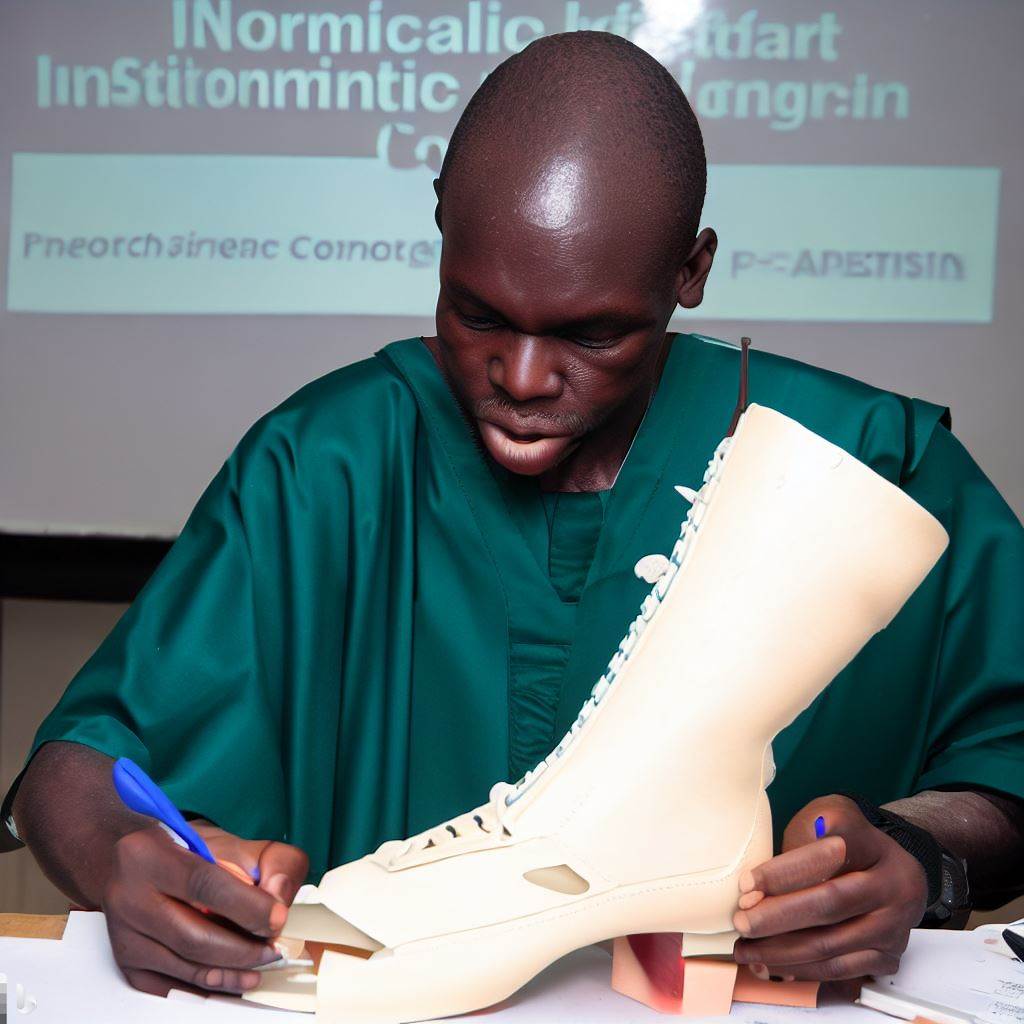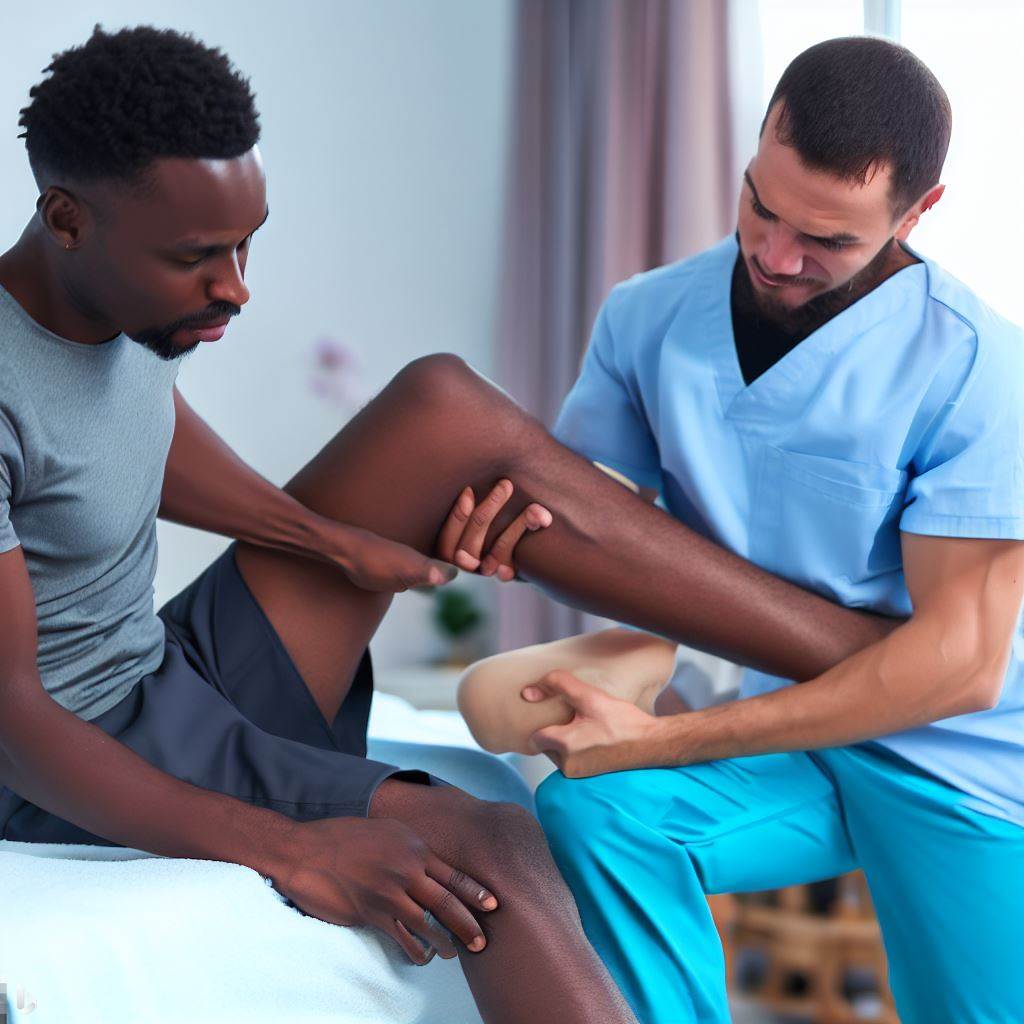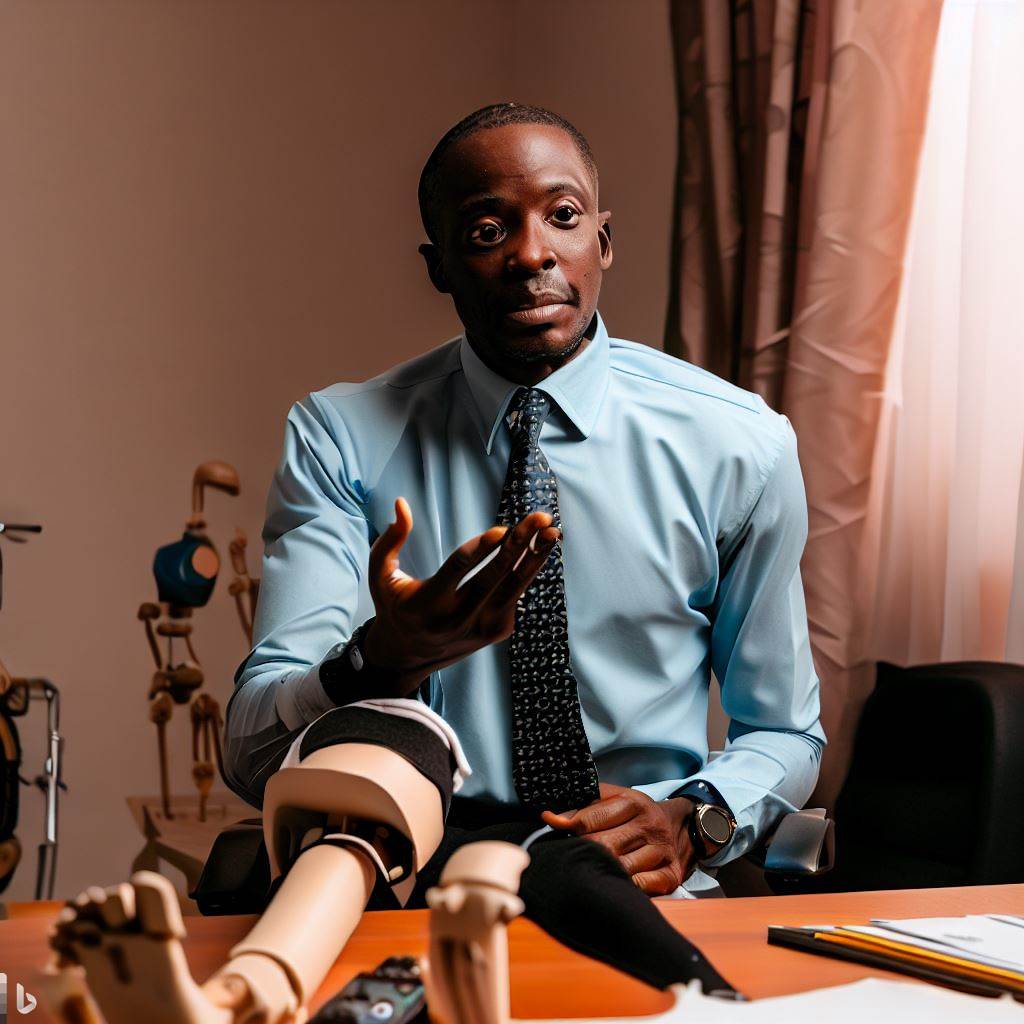Introduction
Orthotics and prosthetics are medical disciplines that involve designing and fitting devices to support or replace body parts.
In Nigeria, orthotic and prosthetic education plays a vital role in improving the quality of life for individuals with physical disabilities.
The curriculum for orthotic and prosthetic education in Nigeria provides students with the necessary knowledge and skills to create and fit orthotic and prosthetic devices.
The education includes both theoretical and practical components, which enable students to understand the science behind orthotics and prosthetics and develop hands-on skills.
The theoretical component of the curriculum covers subjects such as anatomy, physiology, biomechanics, and pathology.
Students learn about the different types of orthotic and prosthetic devices, their functions, and how to assess patients’ needs. They also study the materials used in designing and fabricating these devices.
The practical component of the curriculum focuses on developing technical skills. Students learn how to take accurate measurements, create molds, and fabricate custom-made orthotic and prosthetic devices.
They also learn how to assess patients’ functional needs and provide appropriate fittings and adjustments.
Overall, the orthotic and prosthetic curriculum in Nigeria plays a crucial role in training professionals who can meet the demands of the population with physical disabilities.
By providing a comprehensive education, Nigeria ensures that individuals in need receive high-quality orthotic and prosthetic devices that enhance their mobility and improve their overall well-being.
Background of orthotic and prosthetic curriculum in Nigeria
Historical development of the curriculum
Nigeria’s orthotic and prosthetic curriculum has evolved over the years to meet the country’s healthcare needs.
In the early years, training in orthotics and prosthetics was limited and mostly conducted by foreign experts.
However, recognizing the importance of developing local expertise, Nigeria established its first orthotic and prosthetic training program in 1981.
Since then, the curriculum has been continually refined to align with international standards and cater to the needs of the country.
Major revisions and updates have been made to ensure that graduates receive comprehensive education and training.
The curriculum now covers various aspects, such as anatomy, biomechanics, materials, and clinical practice.
Stakeholders involved in curriculum development
The development of Nigeria’s orthotic and prosthetic curriculum involves collaboration between several stakeholders.
Government bodies, such as the Ministry of Health and the National Board for Technical Education, play a crucial role in setting standards.
Orthotic and prosthetic professionals, both local and international, contribute their expertise to curriculum development.
Academic institutions offering training programs are actively involved in curriculum design and delivery.
Professional associations, like the Nigerian Association of Orthotist and Prosthetist, provide valuable input and ensure industry relevance.
Additionally, feedback from students, healthcare professionals, and patients is taken into account for continuous improvement.
Challenges faced in implementing the curriculum
Implementing the orthotic and prosthetic curriculum in Nigeria has not been without its challenges.
One of the primary obstacles is the shortage of qualified instructors to teach the specialized subjects.
Recruiting and retaining skilled educators remains a constant struggle, impacting the quality and availability of training.
Insufficient funding also poses a challenge, limiting the resources, equipment, and infrastructure for effective teaching.
Another hurdle is the lack of awareness about orthotics and prosthetics within the healthcare community and among patients.
This leads to a limited demand for professionals trained in these fields, affecting the sustainability of the curriculum.
Addressing these challenges requires collaboration between the government, academic institutions, and industry partners to allocate resources, improve training facilities, and raise awareness about the importance of orthotic and prosthetic services.
In general, Nigeria’s orthotic and prosthetic curriculum has come a long way in meeting the healthcare needs of the country.
The historical development showcases a commitment to local expertise, while the involvement of various stakeholders ensures the curriculum’s relevance and quality.
Overcoming challenges in implementing the curriculum is key to sustaining and expanding orthotic and prosthetic services in Nigeria.
Structure of Nigeria’s Orthotic and Prosthetic Curriculum
Pre-requisites for admission into the curriculum
- Applicants must have a minimum of a high school diploma or its equivalent.
- Potential students must possess a good understanding of mathematics and physics.
- Basic knowledge of anatomy, physiology, and biology is required for admission.
- Applicants must pass an entrance examination and interview conducted by the curriculum board.
Duration and format of the program
- The orthotic and prosthetic curriculum in Nigeria is a 4-year undergraduate program.
- It is structured to include both theoretical coursework and practical training.
- The program emphasizes hands-on experience to ensure students develop necessary skills and competencies.
- Students are required to complete a minimum number of credits to graduate from the program.
Course modules and content covered
The curriculum covers a wide range of topics related to orthotics and prosthetics:
- Introduction to Orthotics and Prosthetics
- Anatomy and Physiology
- Biomechanics
- Orthotic Assessment and Prescription
- Prosthetic Assessment and Prescription
- Gait Analysis and Orthotic/Prosthetic Alignment
- Materials Science and Technology
- Orthotic and Prosthetic Workshop Techniques
- Practice Management and Ethics
- Research Methods and Project Work
The curriculum adopts a progressive learning approach, building on foundational knowledge:
- First-year courses focus on basic sciences and introductory orthotics and prosthetics.
- In the second year, students dive deeper into biomechanics and assessment techniques.
- Third-year courses cover more advanced topics like gait analysis and prescription methodologies.
- During the final year, emphasis is placed on workshop techniques, practice management, and research.
Throughout the program, students engage in clinical rotations to gain practical experience:
- They work under the supervision of experienced practitioners in various healthcare settings.
- These rotations provide opportunities to apply theoretical knowledge to real-life patient cases.
- Students are exposed to a variety of orthotic and prosthetic devices and their applications.
- They learn to assess, fabricate, fit, and adjust devices based on individual patient needs.
The curriculum also encourages students to undertake research projects to contribute to the field:
- They learn research methods and engage in data collection, analysis, and interpretation.
- Research projects enable students to explore innovations and improve orthotic and prosthetic practices.
- Students present their findings to faculty and peers, promoting knowledge exchange and collaboration.
In summary, Nigeria’s orthotic and prosthetic curriculum provides a comprehensive education:
- It requires specific pre-requisites for admission to ensure students have foundational knowledge.
- The 4-year program offers a combination of theoretical coursework, practical training, and research opportunities.
- Covering diverse modules, the curriculum equips students with the necessary skills for professional practice.
Read: Success Stories of Nigerian Orthotists and Prosthetists
Core components of the curriculum
Theoretical knowledge
Anatomy and physiology
Students in Nigeria’s orthotic and prosthetic curriculum are required to have a strong understanding of human anatomy and physiology.
Biomechanics
Understanding the principles of biomechanics is essential for students to design and create effective orthotic and prosthetic devices.
Material science
Knowledge of different materials used in orthotics and prosthetics, their properties, and how to choose the right material for each situation.
Practical skills
In Nigeria’s orthotic and prosthetic curriculum, the core components are divided into theoretical knowledge and practical skills.
The theoretical knowledge component focuses on providing students with a solid understanding of essential subjects such as anatomy and physiology.
This foundation enables students to comprehend the complexities of the human body and how it interacts with orthotic and prosthetic devices.
Workshop training
Biomechanics is another crucial area of study, as it allows students to comprehend the mechanical forces that affect the human body.
With this knowledge, students can design and construct devices that provide the necessary support and alignment for patients.
Material science plays a significant role in the curriculum, as students must grasp the different materials available and their specific properties.
Understanding these aspects helps students select the most suitable material for each patient and ensures the successful fabrication of orthotic and prosthetic devices.
Students undergo extensive workshop training where they learn how to use various tools and equipment to fabricate orthotic and prosthetic devices.
Clinical practice
On the practical skills side, students partake in comprehensive workshop training to hone their fabrication abilities. This training grants them the practical know-how for using various tools and equipment required in their field.
Clinical practice is an integral component of the curriculum, providing students with hands-on experience.
Through supervised interactions with patients, students learn how to apply their theoretical knowledge in real-life situations.
This practice enhances their skills in patient care and device fitting, leading to improved outcomes for individuals in need of orthotic and prosthetic support.
Students have the opportunity to gain hands-on experience by working directly with patients under the guidance of experienced professionals.
Patient assessment and management
Students learn how to assess patient needs, develop treatment plans, and manage the overall care of patients requiring orthotic and prosthetic devices.
Patient assessment and management are further crucial components of the curriculum.
Students develop the skills needed to evaluate patients, identify specific requirements, and create personalized treatment plans.
This comprehensive approach ensures that patients receive individualized care and appropriate orthotic and prosthetic solutions.
In fact, Nigeria’s orthotic and prosthetic curriculum encompasses both theoretical knowledge and practical skills.
The curriculum covers essential subjects such as anatomy and physiology, biomechanics, and material science.
Additionally, students receive hands-on training through workshops and clinical practice, allowing them to assess and manage patients effectively.
Read: Orthotic/Prosthetic Patient Experiences in Nigeria

Curriculum implementation and adaptation
Collaboration between educational institutions and healthcare facilities
Collaboration between educational institutions and healthcare facilities is crucial for the successful implementation of Nigeria’s orthotic and prosthetic curriculum.
Working together, these two entities can ensure that the curriculum meets the needs of the healthcare industry.
By collaborating, educational institutions can gain insights into the latest developments in the field, ensuring that their curriculum remains relevant.
Healthcare facilities can also benefit from this collaboration by providing input on the skills and knowledge that are most valuable in the workplace.
Ultimately, this collaboration ensures that graduates of the program are well-prepared to meet the demands of the healthcare industry.
Integration of technology in the curriculum
Incorporating technology into the orthotic and prosthetic curriculum is essential to prepare students for the modern healthcare landscape.
The curriculum should include instruction on the use of advanced tools and technologies that are commonly used in the field.
This may include 3D printing, computer-aided design (CAD) software, and robotic systems.
By incorporating these technologies into the curriculum, students can develop the necessary skills to excel in their future careers.
Additionally, the integration of technology can enhance the learning experience for students, making the curriculum more engaging and interactive.
Continuous professional development and certification
Continuous professional development and certification play a crucial role in ensuring that orthotic and prosthetic practitioners stay up to date with the latest advancements in the field.
Healthcare professionals should have access to ongoing training opportunities to further enhance their knowledge and skills.
Continuing education courses, workshops, and conferences should be available to help practitioners stay current.
Certification programs can also provide a standardized measure of competency for practitioners in the field.
These programs can help validate the skills and knowledge of orthotic and prosthetic professionals, ensuring that they are providing quality care to patients.
Furthermore, certification can foster professional growth and advancement opportunities for practitioners.
In short, the successful implementation and adaptation of Nigeria’s orthotic and prosthetic curriculum rely on collaboration between educational institutions and healthcare facilities.
Integration of technology and continuous professional development and certification are also vital components.
By prioritizing these aspects, Nigeria can ensure that its orthotic and prosthetic curriculum remains relevant and prepares students for the evolving healthcare industry.
Review: Understanding the Salary Scale for Lab Technicians in Nigeria
Challenges and Future Prospects of the Curriculum
Limited resources and infrastructure
The orthotic and prosthetic curriculum in Nigeria faces challenges due to limited resources and inadequate infrastructure.
These limitations hinder the practical training and hands-on experience necessary for students in this field.
Shortage of qualified instructors
Another major obstacle faced by the curriculum is the shortage of qualified instructors in orthotic and prosthetic education.
This shortage negatively impacts the quality of education provided to students and restricts their learning opportunities.
Importance of curriculum review and improvement
Given the challenges faced, it is crucial to regularly review and improve the orthotic and prosthetic curriculum in Nigeria.
Publish Your Professional Profile, Business or Brand
Showcase your expertise, gain trust, and boost visibility instantly on Professions.ng.
Publish NowThis review process should involve industry experts, educators, and stakeholders to ensure relevance and effectiveness.
Potential advancements in orthotic and prosthetic education
Despite the challenges, there are several future prospects for the curriculum in Nigeria.
The advancements in technology and innovation present opportunities for modernizing teaching methods and practical training.
Utilizing virtual reality, simulation labs, and 3D printing can enhance learning outcomes and prepare students for real-world scenarios.
Incorporating research and evidence-based practices into the curriculum can also ensure students are up-to-date with the latest advancements.
Moreover, collaborations with international institutions and experts can provide valuable insights and exchange of knowledge.
These partnerships can contribute to the growth and development of the orthotic and prosthetic curriculum in Nigeria.
In review, the orthotic and prosthetic curriculum in Nigeria faces challenges related to limited resources, shortage of qualified instructors, and infrastructure constraints.
However, with a comprehensive review and improvement process, the curriculum can be enhanced to meet the demands of the field.
Furthermore, advancements in technology and collaborations with global partners offer promising future prospects for the curriculum.
By addressing these challenges and embracing opportunities, Nigeria can develop a robust orthotic and prosthetic curriculum that prepares students for successful careers in the field.
Read: Regulations Governing Prosthetist Practice in Nigeria
Conclusion
Nigeria’s orthotic and prosthetic curriculum plays a crucial role in addressing the needs of individuals with physical disabilities in the country.
It provides comprehensive training and education for practitioners in the field.
Ongoing support and investment are essential to ensure the success and continuous improvement of the curriculum.
This includes financial resources, equipment, and collaboration with international organizations to bring the latest advancements to Nigeria.
Interested individuals and organizations have an opportunity to make a difference by contributing to the development of the curriculum.
By sharing expertise, resources, and funding, they can help improve the quality of care and services provided to those in need.
Together, we can bridge the gap in access to orthotic and prosthetic services in Nigeria and empower individuals with physical disabilities to live fulfilling lives.




